Our feet do the hard work of bearing our weight and getting us from point A to point B. But generally, we don’t pay too much attention to our feet until they start hurting.
As podiatrists, we hear the question “why does my foot hurt?” all the time. There are countless possible causes of foot pain, from stress fractures to nerve damage.
So today we’re going to focus on 10 of the more common conditions related to foot and ankle pain. Drumroll, please!
1. What is Plantar Fasciitis?
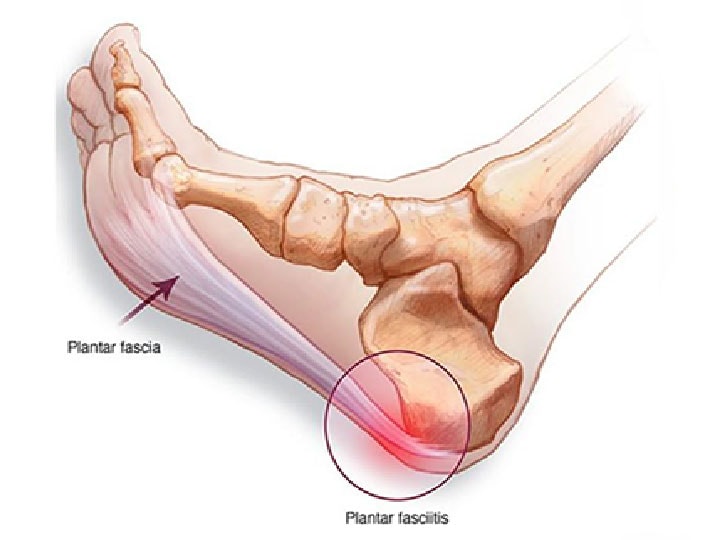
One of the most common triggers of bottom of foot pain is plantar fasciitis. The plantar fascia is a ligament that runs across the bottom of the foot, connecting your toes to your heel bone. Inflammation or irritation of the plantar fascia due to overuse results in pain at the bottom of the foot, often near the heel.
Plantar Fasciitis symptoms include:
-
- morning foot pain just after waking
- foot pain after intense exercise
- sharp pain in the heel with the first few steps in the morning or foot pain after sitting for an extended period of time
- heel pain when climbing stairs
Plantar fasciitis is known as an overuse injury. Common causes are high-impact activities like running, wearing shoes with high arches, or other activities that put extra tension or stress on the heel.
Plantar Fasciitis Treatment and Prevention
Wearing wide, supportive shoes can alleviate stress on your feet and help prevent irritation of the plantar fascia.
If you’re experiencing plantar fascia pain, over-the-counter pain medication and ice may help relieve symptoms. The plantar fascia is part of a system that stretches from the calf muscles to the Achilles tendon, so stretching your feet and lower legs can also help relieve pain.
What are heel spurs?
Another common cause of heel of foot pain is heel spurs. Heel spurs are bony protrusions from the heel bone that can be a problem all on their own. But they can also cause tightness of the plantar fascia, leading to plantar fasciitis.
Because these two conditions can be similar (or related!) it can be tricky to diagnosis the root of the problem. Dr. Gina Nalbandian, a podiatrist at UFAI, has said of heel spurs and plantar fasciitis, “You would be surprised how often patients we see have been misdiagnosed for these two conditions.”
2. What is a Bunion?
Bunions are bumps that form at the base of the big toe and can shift the bones if left untreated. These foot deformities are very common because they have a wide variety of causes including: genetics, structural abnormalities of the foot, pregnancy, rheumatoid arthritis, and long-term wearing of high-heeled or pointy shoes.
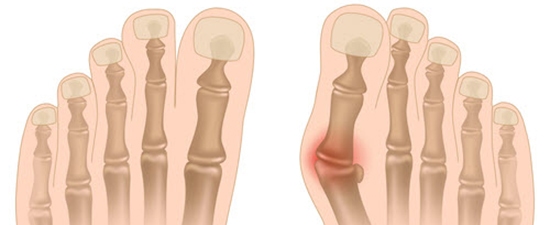
Bunion Symptoms include:
-
- bump at base of the big toe
- swelling, redness, or soreness at the base of the big toe joint
- corns or calluses where the first and second toe are pushed together
Bunion Treatment and Prevention
The key step to preventing the formation or progression of bunions is wearing well-fitting shoes. If a bunion has formed, custom orthotics, stretches, and bunion pads can help manage bunion pain, but they will not stop its progression. In many cases, once it progresses to a point where the pain is interfering with the quality of your life, surgery may very well be necessary.
Learn more about our minimally invasive bunion surgery.
3. What is Morton’s Neuroma?
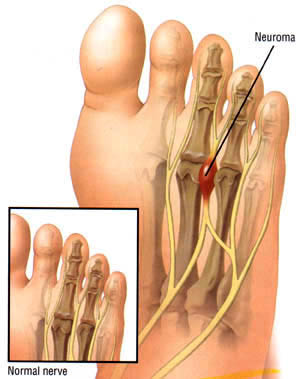
Morton’s neuroma isn’t super common, but it happens enough that you should be aware of it. Especially if you wear high heels! Wearing tight, narrow, high-heeled shoes compresses the toes and (eventually) thickens the tissues around the toes’ nerves. This developed growth normally occurs between the third and fourth toes and is known as a neuroma.
Morton’s Neuroma Symptoms include:
-
- burning or stinging ball of foot pain
- numbness in the ball of your foot
Morton’s Neuroma Treatment and Prevention
Wearing supportive, spacious shoes can prevent or relieve neuroma pain. More advanced Morton’s neuroma may require physical therapy or cortisone injections to alleviate the pain and other symptoms. In the most extreme cases, surgery may be required to remove the neuroma or repair the nerve.
4. What are Hammertoes?
Hammertoes look more like claws than nice, straight toes. The constant contraction of the muscles pulls the toes up like a hammer, causing part of the toe to rub against your shoes. This continuous friction results in sores and (in worst-case scenarios) ulceration.
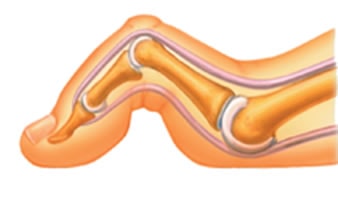
Hammertoe Symptoms include:
- pain, blisters, or calluses on the top of the toes
- curled toes
- ball of foot pain
Hammertoe Treatment and Prevention
While hammertoes are sometimes caused by muscle imbalances, they can also be caused by ill-fitting shoes. So to prevent hammertoes, make sure to wear properly fitting shoes with good arch support. If you’re already suffering from a hammertoe, changing to better shoes or using orthotic inserts can help alleviate symptoms.
5. What is Rheumatoid Arthritis?
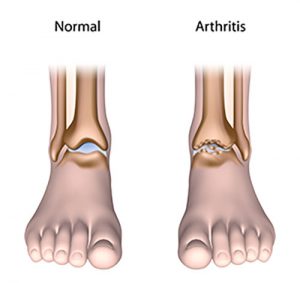
Rheumatoid arthritis (RA) is a chronic inflammatory disorder. It affects the whole body, not just the feet. A common side effect is that bones start to deviate.
Rheumatoid Arthritis Symptoms include:
-
- stiff, swollen, and tender joints
- toe pain
Rheumatoid Arthritis Treatment and Prevention
While osteoarthritis is caused by wear and tear on the joints, rheumatoid arthritis is an autoimmune disease. As such, there is no real way to prevent RA. At the first sign of symptoms (or if any family members had RA), see a doctor for diagnosis and treatment. Conservative treatments include shoe inserts, physical therapy, ibuprofen, and steroid injections to the joint. More advanced or severe RA may require surgery.
6. What is Gout
A type of arthritis, gout can be hereditary or caused by kidneys not functioning properly. Uric acid crystals build up and accumulate in colder body parts (often the toes). Some of the symptoms of gout are similar to the symptoms of infection, so it’s important to see a doctor sooner rather than later for proper diagnosis.
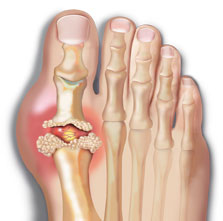
Symptoms of Gout in Feet include:
-
- pain in the toes
- swollen joints
- joints that feel hot, look red, and are sensitive to touch
Gout Treatment and Prevention
If you’re at risk for gout, limit your intake of seafood, heavy sauces, meats, and other foods likely to cause a uric acid increase. To treat the symptoms of gout, rest the foot, ice the area, and take nonsteroidal anti-inflammatory drugs.
7. What is Turf Toe?
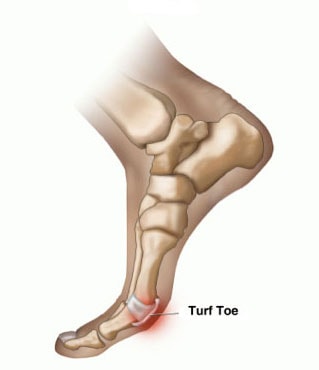
Turf toe is a fairly common sprain at the base of the big toe; it develops when the big toe is bent back beyond its usual range of motion. It gained the name “turf toe” because it’s more likely to occur on artificial turf than natural grass.
Turf Toe Symptoms Include:
-
- toe cramping
- pain when running or walking
- swelling and bruising around the joint
Your doctor will probably perform an X-ray to confirm the turf toe diagnosis.
Turf Toe Treatment and Prevention
Physical therapy can alleviate inflammation around the toe and restore mobility. Turf toe can be difficult to prevent, as it’s caused by accidents. However, wearing stiff-soled shoes when exercising will help protect the big toe joint from injury. And stretching thoroughly before exercise or sports can decrease your chances of severe injury.
8. What is Posterior Tibial Tendonitis
The posterior tibialis is a tendon attaching the bottom of the foot to the inner lower leg. Tendonitis of the posterior tibialis is one of the most common ankle and foot problems.
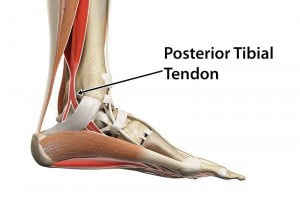
Posterior Tibial Tendonitis Symptoms include:
- pain alongside the inside of the foot and ankle
- activity (such as running or walking for long periods of time) makes pain worse
- outside of the ankle pain
This condition is caused by inflammation or tearing of the posterior tibial tendon and causes instability of the ankle. If left untreated, this condition can cause flatfoot.
Posterior Tibial Tendonitis Treatment & Prevention
Balance exercises and exercises that increase ankle strength and flexibility can prevent irritation and inflammation of the tendon.
If you’re suffering from posterior tibial tendonitis, orthotics and anti-inflammatory medications can be helpful treatment options.
9. What is Metatarsalgia?
Often referred to as “ball of foot pain,” metatarsalgia covers a variety of foot problems. Heel pain is often a contributor to metatarsalgia; pain in the heel makes you adjust the way you walk which can result in pain of the metatarsal heads (essentially your toes’ knuckles).
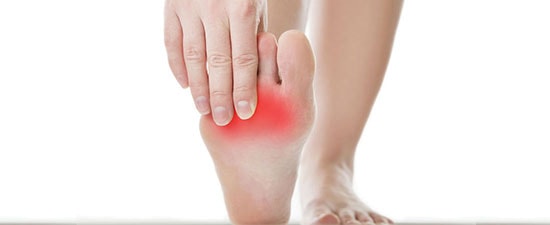
Metatarsalgia Symptoms Include:
-
- pain near the toes
- numbness or tingling in the toes
- increased pain when running or walking
Metatarsalgia Treatment and Prevention
Properly fitting, well-cushioned shoes are one way to prevent metatarsalgia. Your doctor may recommend custom-made orthotics for treating or preventing metatarsalgia pain.
10. What is Tarsal Tunnel Syndrome?
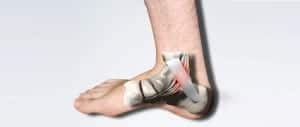
You’ve probably heard of “carpal tunnel syndrome,” the compression of a nerve in the wrist. Tarsal tunnel syndrome occurs when the main nerve to the feet gets compressed by tissue or bone.
Tarsal Tunnel Syndrome Symptoms Include:
- shooting pain on the inside of the foot
- tingling or burning feeling on the foot
Tarsal Tunnel Syndrome Treatment and Prevention
Rest and anti-inflammatory medication can help relieve pain while stretching or physical therapy can relieve the compression. Properly warming up before exercise and maintaining ankle strength and flexibility can help prevent tarsal tunnel syndrome from developing.
When should I see a doctor for foot pain?
Every situation is different but in general, the warning signs that mean you should see a podiatrist are:
- Signs of Infection: redness, warmth, and tenderness in an area of the foot
- Open Wounds: especially with pus or discharge
- Severe Pain: if it’s too painful to do daily activities, over-the-counter medications aren’t helping, or the pain lasts several days
- Not Healing: if a wound isn’t healing or improving, see a healthcare professional (especially if you’re diabetic or have another condition that inhibits healing)
Why choose University Foot and Ankle Institute for foot or ankle pain?
From RA and bunions to ankle sprains and ingrown toenails, we’re committed to overall foot wellness for our patients. Our nationally recognized foot and ankle specialists offer the most advanced podiatric care and the highest success rates in the nation. We are leaders in researching, diagnosing, and treating all foot and ankle conditions.
At University Foot and Ankle Institute, we take our patients’ safety seriously. Our facility’s Covid-19 patient safety procedures exceed all CDC recommendations.
For more information or to schedule a consultation in the greater Los Angeles area, please call (877) 736-6001 or make an appointment now.
University Foot and Ankle Institute is conveniently located throughout Southern California and the Los Angeles area as our foot doctors are available at locations in or near Santa Monica, Beverly Hills, West Los Angeles, Manhattan Beach, Northridge, Downtown Los Angeles, Westlake Village, Granada Hills, and Valencia, California.
- Could Feet Be the Windows to Your Health? - May 24, 2024
- Is Foot Analysis Better than Horoscopes? What Do Your Toes Reveal About Your Personality? - May 7, 2024
- The Link Between Foot Health and Posture - April 14, 2024